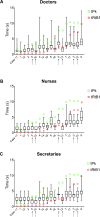Man versus machine: comparison of naked-eye estimation and quantified capillary refill
- PMID: 31308133
- PMCID: PMC6678056
- DOI: 10.1136/emermed-2018-207948
Man versus machine: comparison of naked-eye estimation and quantified capillary refill
Abstract
Background: Capillary refill (CR) time is traditionally assessed by 'naked-eye' inspection of the return to original colour of a tissue after blanching pressure. Few studies have addressed intra-observer reliability or used objective quantification techniques to assess time to original colour. This study compares naked-eye assessment with quantified CR (qCR) time using polarisation spectroscopy and examines intra-observer and interobserver agreements in using the naked eye.
Method: A film of 18 CR tests (shown in a random fixed order) performed in healthy adults was assessed by a convenience sample of 14 doctors, 15 nurses and 19 secretaries (Department of Emergency Medicine, Linköping University, September to November 2017), who were asked to estimate the time to return to colour and characterise it as 'fast', 'normal' or 'slow'. The qCR times and corresponding naked-eye time assessments were compared using the Kruskal-Wallis test. Three videos were shown twice without observers' knowledge to measure intra-observer repeatability. Intra-observer categorical assessments were compared using Cohen's Kappa analysis. Interobserver repeatability was measured and depicted with multiple-observer Bland-Altman plotting. Differences in naked-eye estimation between professions were analysed using ANOVA.
Results: Naked-eye assessed CR time and qCR time differ substantially, and agreement for the categorical assessments (naked-eye assessment vs qCR classification) was poor (Cohen's kappa 0.27). Bland-Altman intra-observer repeatability ranged from 6% to 60%. Interobserver agreement was low as shown by the Bland-Altman plotting with a 95% limit of agreement with the mean of ±1.98 s for doctors, ±1.6 s for nurses and ±1.75 s for secretaries. The difference in CR time estimation (in seconds) between professions was not significant.
Conclusions: Our study suggests that naked-eye-assessed CR time shows poor reproducibility, even by the same observers, and differs from an objective measure of CR time.
Keywords: acute care; clinical assessment; emergency department management; resuscitation; trauma.
© Author(s) (or their employer(s)) 2019. Re-use permitted under CC BY-NC. No commercial re-use. See rights and permissions. Published by BMJ.
Conflict of interest statement
Competing interests: RTJ and DBW have no conflicts of interest to declare. The bioengineering method TiVi is marketed by the company WheelsBridge AB. No financial support from WheelsBridge AB was involved in the conduct of the study. JH is employed by the Östergötland County Council but has a royalty agreement with WheelsBridge AB. CDA has a full-time academic position but also limited involvement in WheelsBridge AB.
Figures



Similar articles
-
Can we trust naked eye assessments of the capillary refill test in children? An experimental study.BMC Emerg Med. 2025 Mar 28;25(1):48. doi: 10.1186/s12873-025-01204-0. BMC Emerg Med. 2025. PMID: 40155796 Free PMC article.
-
The prediction of pouch of Douglas obliteration using offline analysis of the transvaginal ultrasound 'sliding sign' technique: inter- and intra-observer reproducibility.Hum Reprod. 2013 May;28(5):1237-46. doi: 10.1093/humrep/det044. Epub 2013 Mar 12. Hum Reprod. 2013. PMID: 23482338
-
Lack of agreement between different observers and methods in the measurement of capillary refill time in healthy volunteers: an observational study.Rev Bras Ter Intensiva. 2014 Jul-Sep;26(3):269-76. doi: 10.5935/0103-507x.20140038. Rev Bras Ter Intensiva. 2014. PMID: 25295821 Free PMC article.
-
Observer variation in the diagnosis of thyroid disorders. Criteria for and impact on diagnostic decision-making.Dan Med Bull. 2000 Nov;47(5):328-39. Dan Med Bull. 2000. PMID: 11155660 Review.
-
Microscopy.2018 Aug 3. In: Maier A, Steidl S, Christlein V, Hornegger J, editors. Medical Imaging Systems: An Introductory Guide [Internet]. Cham (CH): Springer; 2018. Chapter 5. 2018 Aug 3. In: Maier A, Steidl S, Christlein V, Hornegger J, editors. Medical Imaging Systems: An Introductory Guide [Internet]. Cham (CH): Springer; 2018. Chapter 5. PMID: 31725223 Free Books & Documents. Review.
Cited by
-
Quantitative Evaluation of Microcirculatory Alterations in Patients with COVID-19 and Bacterial Septic Shock through Remote Photoplethysmography and Automated Capillary Refill Time Analysis.Medicina (Kaunas). 2024 Oct 14;60(10):1680. doi: 10.3390/medicina60101680. Medicina (Kaunas). 2024. PMID: 39459467 Free PMC article.
-
Can we trust naked eye assessments of the capillary refill test in children? An experimental study.BMC Emerg Med. 2025 Mar 28;25(1):48. doi: 10.1186/s12873-025-01204-0. BMC Emerg Med. 2025. PMID: 40155796 Free PMC article.
-
Optical Fibre Sensor for Simultaneous Measurement of Capillary Refill Time and Contact Pressure.Sensors (Basel). 2020 Mar 3;20(5):1388. doi: 10.3390/s20051388. Sensors (Basel). 2020. PMID: 32138378 Free PMC article.
-
Pulse oximetry-based capillary refilling evaluation predicts postoperative outcomes in liver transplantation: a prospective observational cohort study.BMC Anesthesiol. 2020 Sep 29;20(1):251. doi: 10.1186/s12871-020-01171-y. BMC Anesthesiol. 2020. PMID: 32993506 Free PMC article.
-
Research Progress on the Measurement Methods and Clinical Significance of Capillary Refill Time.Sensors (Basel). 2024 Dec 12;24(24):7941. doi: 10.3390/s24247941. Sensors (Basel). 2024. PMID: 39771680 Free PMC article. Review.
References
-
- American College of Surgeons CoT ATLS advanced trauma life support for doctors student’s course manual. 8th ed: American College of Surgeons, 2008:3–366.
-
- Advanced Life Support Group. Oxford. England: Wiley-Blackwell Publishing Ltd, 2005.
-
- Group ALS. Circulation assessment Acute medical emergencies. 2nd ed England: Oxford; Wiley-Blackwell Publishing Ltd, 2010:55–65.
-
- Beecher HK, Simeone FA. The internal state of the severely wounded man on entry to the most forward hospital. Surgery 1947;22:672–711. - PubMed
